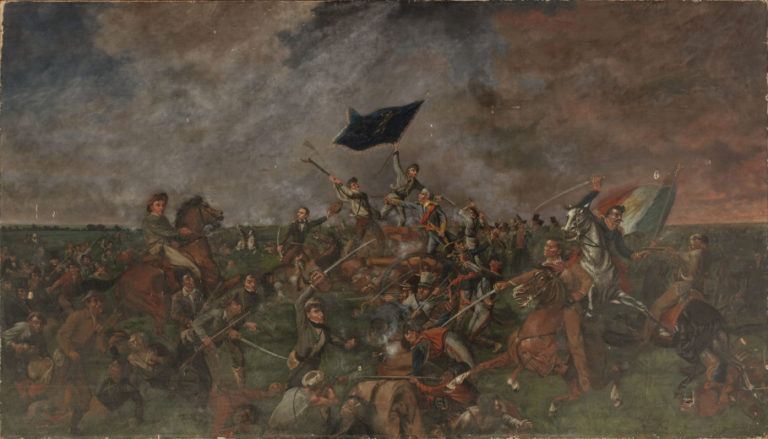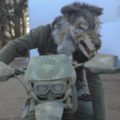The Hertiage Auction Galleries just recently auctioned off a painting that a man found in his attic of his West Virginia home, covered with dust. The man happened to be the great-great-grandson of artist, H.A. McArdle. The painting which was discovered illustrats the Texas Revolution’s critical 1836 Battle of San Jacinto. It had been missing for almost a hundred years. This discovery landed the artist’s great-great-grandson a cool $334,600
From HA.com
HENRY ARTHUR (HARRY) MCARDLE (American, 1836-1908)
The Battle of San Jacinto, 1901
Oil on canvas
48 x 84 inches (121.9 x 213.4 cm)
Signed, dated, and inscribed lower right: H.A. McArdle / 1901 / Painted for J.T. DeShieldsPROVENANCE:
H.A. McArdle;
By descent to Marie McArdle;
By descent to George Bland;
By descent to Elisabeth Bland.H.A. (Harry) McArdle was born in Belfast, Ireland, in 1836; the same year that the Battle of San Jacinto was fought and Texas won its independence. He came to America as an orphan in 1850 and ten years later enrolled at the Maryland Institute of Art, where he won the prestigious Peabody Prize. After enlisting in the Confederate army, McArdle became a draftsman for the Confederate Navy. He later served with General Robert E. Lee in his first campaign in West Virginia on the engineer staff.
After the Civil War, McArdle began work on Lee in the Wilderness, his first battle painting. In the winter of 1868, McArdle and his family moved to Independence, Texas, and McArdle continued working on Lee in the Wilderness, using veterans of Hood’s Texas Brigade living in the area. After finishing the painting, which was later destroyed in a fire at the Texas State Capitol in 1881, McArdle became interested in the Texas Revolution from conversations he had with the veterans. In the 1880s, he began work on recreating Dawn at the Alamo (completed 1905), as the first version burned in the 1881 fire. At the same time, he also began painting a new work, The Battle of San Jacinto, which was completed in 1895.
In 1901, McArdle painted an alternate version of The Battle of San Jacinto. Commissioned by J.T. DeShields, this later version of the 1895 mural was believed lost by scholars. In his book, Painting Texas History to 1900, Sam Ratcliffe briefly mentions, “a slightly scaled-down (5′ x 7′) version of San Jacinto, which is unlocated.” It remained a mystery until this year when Jon Buell, the artist’s great-great grandson, discovered it in the attic of his family’s home in West Virginia. Due this astonishing find, we now know that later version of The Battle of San Jacinto is not a study or a copy but an original reimagining of the subject.
When it arrived in Dallas, the painting was sent to two conservators. Infrared pictures, which make it possible to see below the top layer of paint, were taken to see mistakes that McArdle changed later. For example, in this infrared detail the original placement of the flag is visible to the right as a white ghost image. These corrections give insight into the way that he adapted elements from the first version into a new composition. It is extremely dirty, and there are some small holes but the painting can be cleaned and repaired. A very small area was test cleaned so that it is now possible to get an idea of how spectacular the colors, particularly those found in the sky during sunset, will look after conservation. The general conclusion from the experts was that the painting should not be “over conserved.” It is in relatively good condition, especially considering its history, and can be restored to its former glory.
The first San Jacinto hangs across the room of the Senate chamber at the Texas State Capitol from McArdle’s other mural Dawn at the Alamo. Together these iconic images shape the story of the Texas Revolution. McArdle’s treatment of the Battle of San Jacinto subject has been celebrated as one of the most accurate image of the battle ever created. He exhaustively researched the painting, going so far as to survey the battlefield and interview veterans while at the site and through correspondence. With this information he recreated the first San Jacinto in what has been called his ‘Topographic’ style, in which the viewer gazes down on the chaos of the sprawling battle below.
In contrast, McArdle returned to a more traditional pyramid-shaped composition in the later version of San Jacinto. This approach was the same type of heroic arrangement that he employed in his earlier work, Lee in the Wilderness. For hundreds of years history painters, like John Trumbull and John Singleton Copely, have often favored similar compositions. In them, the most important figures and celebrated moments of the battle are extracted and refined into one idealized moment.
The most celebrated figures from the battle include Sam Houston, Henry W. Karnes, Deaf Smith, Edward Burleson, and Andrew Briscoe from the Texas side and Mexicans Antonio Trevino, Don Moro Esteban, and Don Manual Castrillon. It is not surprising that DeShields, a historian and patron who was passionate about telling the story of Texas Revolution, might commission such a painting. This discovery has allowed us amazing insight into how McArdle and DeShields helped to shape the narrative of the Texas Revolution and create the myth of Texas.



